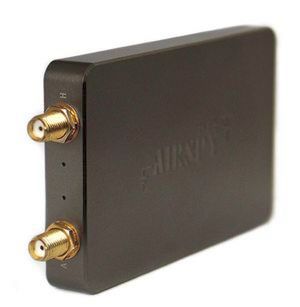Here’s my comparison of the new AirSpyHF+ plus vs the RF Space netSDR. The netSDR is one of the higher end SDRs, often considered the “gold standard”. So how does the AirSpyHF+ match up?

The AirSpyHF+ has two Sigma Delta ADCs with a 36 MSPS rate, an 18 bit DDC (Digital Down Converter) and (near as I can tell) always produces a 768 kHz I/Q stream. The frequency range is 9 kHz to 31 MHz, then 60 to 260 MHz. The selling price is about $199.

The netSDR has a 16 bit A/D, sampling at 80 MHz. The frequency range is 10 kHz to 32 MHz, which can be extended to over 1 GHz with the Downconverter option. I/Q stream rates are up to 2000 kHz. The list price was $1449.
I fed both receivers with the same antenna, my Crossed Parallel Loop, through a splitter. The AirSpyHF+ always samples at a 768 kHz rate, I set the netSDR to a 625 kHz rate, the closest. SdrDx software was used in both cases to make the I/Q recordings. In the case of the AirSpyHF+ I used my own server app to feed the I/Q data to SdrDx. I then recorded the 25 and 19 meter bands, and selected several transmissions to compare. In both cases, mySdrPlayback (an app I wrote) was used to playback the I/Q recordings and convert to WAVE audio, which was then converted to mp3 at a 64 kbit rate. I tried to start each record at about the same time and used the same IF filter width, for fairness.
I also made one set of recordings of a relatively low power pirate radio station that plays Christmas music. I think it’s pushing the Part 15 limits, but still is not very powerful, and is probably about ten miles away.
Many of these recordings are of weak signals. There’s no doubt that most any modern SDR is going to do well with strong stations. A more important question is, how to do they work with weaker signals?
So how do you think each receiver performed? Let me know in the comments.
All India Radio 11560 kHz 1443 UTC
netSDR
China Radio International 11785 kHz 1143 UTC
netSDR
Yemen 11860 kHz 1444 UTC
netSDR
Radio Liberty 11890 kHz 1444 UTC
netSDR
China Radio International 11920 kHz 1144 UTC
netSDR
Radio Liberty 15265 kHz 1452 UTC
netSDR
VOA 15580 kHz 1452 UTC
netSDR
China Radio International 15160 kHz 1144 UTC
netSDR
Pirate radio station (about 10 miles away) on 1620 kHz 1536 UTC
netSDR

To my ears I’m not detection much difference between the two. I would have to call it a draw.
Just an ever so slight advantage to the NetSDR when listening to the 1620 pirate.
After listening to all the samples above, I had come to the same conclusions that Mike Bott came to. I could not tell any real significant differences between the two SDR’s for receive quality. Considering that one SDR is $1449.00 if I read correctly, and the AirSpyHF+ is $199.00 the difference there is pretty clear to me. Cost wise it is a no brainer which one I am going to purchase.
Like other commenters noted. They sound about the same. But there is more to consider in an SDR such as how much of the band can you *see* at one time, overload characteristics etc. Some of that is the software used and not just the hardware. Overall tho I think the AirSpy is probably a good priced item.
Hi, could you make some more recordings for a weak station with a strong one very closed?
Why not record some digital signals (eg. Digital Radio Mondial ) and compare SNR directly. This is the most objective test method you can get. It can also reveal some subtle characters in the SDR that is “inaudible” to human ears.
Digital Radio Mondial over shortwave is like lipstick on a pig.
Can you elaborate on that point and your experience?
good test Chris. Fascinating result ..